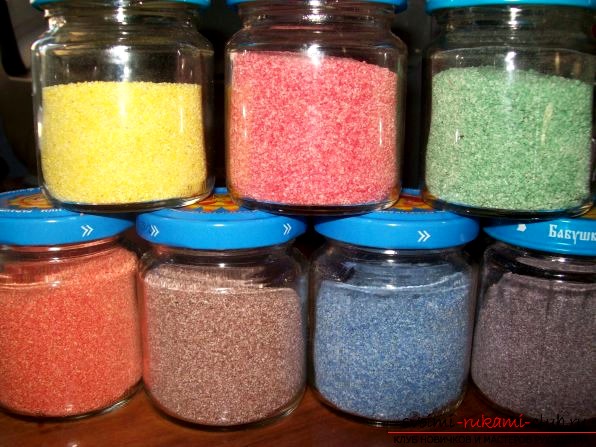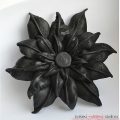
Learn how to make colored sand by yourself and how to use it.
Colored sand is a very interesting material forcreativity. It is especially interesting to work with this material for children. Classes with colored sand very well develop a wealth of tactile sensations, as well as fine motor skills in children of different ages.  Today you can buy whole sets of finishedcolored sand and stencils for creating drawings. But it is much more interesting and, moreover, it is cheaper to create such sand yourself. For this purpose, you can use river sand, as well as ordinary manga or fine salt.
Today you can buy whole sets of finishedcolored sand and stencils for creating drawings. But it is much more interesting and, moreover, it is cheaper to create such sand yourself. For this purpose, you can use river sand, as well as ordinary manga or fine salt.  Options for creating colored sand by yourselfThere are a few. For example, you can take sand or salt and pour into a container with a tight-fitting lid. Then add any dye and mix thoroughly. After the dye is evenly distributed over the sand, it must be left for 30 minutes so that the paint is well absorbed. Next, take the sand, pour a thin layer on paper or a paper towel and leave until completely dry. After that you can start creating masterpieces. For young children, it is better to make colored sand from mango or salt, because the baby may want to taste this substance. You can paint a manga or a fine salt using ordinary pencils. For this, a colored lead is taken and finely ground, and then this dust is mixed with the mancha until it is colored. However, in this way it is difficult to get saturated colors. Using the following method, you can get a large palette of colors. Although this method is longer, unlike the previous one. So, you need to take a container and pour there 2 table spoons of alcohol or vodka, which will serve as a solvent. Then add the paint, you can use ordinary gouache, and mix thoroughly. In this mixture, we pour 4 tablespoons of semolina or fine salt. And start to mix. During this action, alcohol will evaporate, and we will get a painted moist semi-finished product. Now you can put the croup on paper and dry it well. The thinner the layer, the faster the croup will dry out. After drying, the salt or mango can be sieved through a sieve to give too large pieces and obtain a homogeneous mass. Store colored sand better in jars that you can close. Thus, it will be securely closed, moreover, it is convenient to pour the necessary amount of sand from the jars.
Options for creating colored sand by yourselfThere are a few. For example, you can take sand or salt and pour into a container with a tight-fitting lid. Then add any dye and mix thoroughly. After the dye is evenly distributed over the sand, it must be left for 30 minutes so that the paint is well absorbed. Next, take the sand, pour a thin layer on paper or a paper towel and leave until completely dry. After that you can start creating masterpieces. For young children, it is better to make colored sand from mango or salt, because the baby may want to taste this substance. You can paint a manga or a fine salt using ordinary pencils. For this, a colored lead is taken and finely ground, and then this dust is mixed with the mancha until it is colored. However, in this way it is difficult to get saturated colors. Using the following method, you can get a large palette of colors. Although this method is longer, unlike the previous one. So, you need to take a container and pour there 2 table spoons of alcohol or vodka, which will serve as a solvent. Then add the paint, you can use ordinary gouache, and mix thoroughly. In this mixture, we pour 4 tablespoons of semolina or fine salt. And start to mix. During this action, alcohol will evaporate, and we will get a painted moist semi-finished product. Now you can put the croup on paper and dry it well. The thinner the layer, the faster the croup will dry out. After drying, the salt or mango can be sieved through a sieve to give too large pieces and obtain a homogeneous mass. Store colored sand better in jars that you can close. Thus, it will be securely closed, moreover, it is convenient to pour the necessary amount of sand from the jars.  Good luck in creating masterpieces!
Good luck in creating masterpieces!




